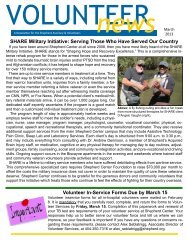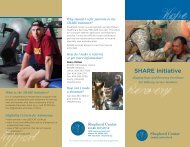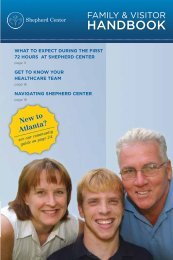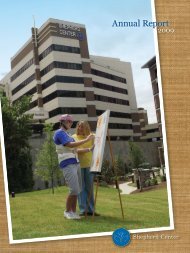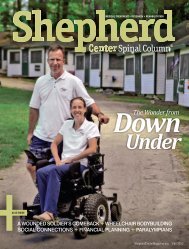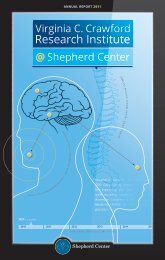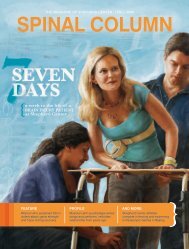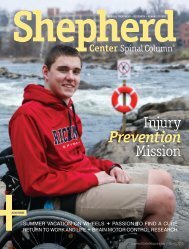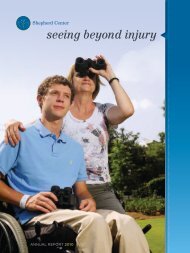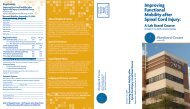Download Guide - Shepherd Center
Download Guide - Shepherd Center
Download Guide - Shepherd Center
You also want an ePaper? Increase the reach of your titles
YUMPU automatically turns print PDFs into web optimized ePapers that Google loves.
ebuilding, together<br />
a guide for caregivers<br />
courtesy of shepherd center
You will likely get a lot of information about spinal cord injury in<br />
the coming days. Caregivers, well-meaning friends, the Internet,<br />
spinal cord injury support groups, and families of other patients<br />
are all good sources of information, but it’s a lot to take in. Don’t<br />
try to learn everything at one time. Rely on your loved one’s<br />
professional caregivers to let you know what you need to be<br />
concerned about next. You’ve come to the right place, and your<br />
loved one is in the hands of experienced caregivers.
Spinal Cord Injury Rehabilitation<br />
1<br />
The first few hours, days and weeks following a spinal<br />
cord injury are a scary and difficult time for a patient’s<br />
loved ones. Getting over the shock of the initial injury<br />
and learning everything you need to know about what<br />
will come next can sometimes be overwhelming.<br />
Recovery from spinal cord injury is unpredictable, and that can be very frustrating. The<br />
medical world is sometimes fast-paced, and care happens around the clock. There is a whole<br />
new language to learn. Answers may seem hard to come by right now. Understanding all of<br />
this and what it means for your loved one will come in time. Right now, you need to do what<br />
you can to cope and to take care of yourself, hour by hour and then day by day.<br />
In the pages of this booklet, you’ll find information and advice that will help you through<br />
these first weeks. You’ll also find comments from families of patients who have traveled<br />
this road before you.<br />
But more than anything else, they want you to know it’s going to be OK.<br />
Whatever level of recovery your loved one makes, you are surrounded by a team of<br />
knowledgeable and caring professionals who will help you make the changes you’ll<br />
need to make to return to a more normal daily routine.<br />
What you will find in this booklet:<br />
– Spinal Cord Injury 101<br />
– What to Expect<br />
– What You Can Do<br />
– Taking Care of Yourself<br />
– Resources
2<br />
Spinal Cord Injury Rehabilitation<br />
spinal cord injury 101<br />
The most important — and sometimes frustrating — thing to know is that<br />
every person’s recovery from spinal cord injury is different. Doctors will make<br />
educated predictions based on the location, type and extent of injury, but in the<br />
end, each person’s recovery will be unique. Spinal cord injury can affect<br />
a person physically, as well as emotionally.<br />
Some problems we will look for include:<br />
• Physical<br />
• Loss of sensation (feeling)<br />
• Loss of movement<br />
• Changes in bowel and<br />
bladder control<br />
• Inability to cough<br />
• Inability to breathe properly<br />
• Changes in blood pressure<br />
and circulation<br />
• Changes in skin integrity<br />
• Emotional<br />
• Denial<br />
• Depression<br />
• Anxiety<br />
• Grief<br />
• Anger<br />
Some information about the spinal cord<br />
• Your neck and backbones (also called vertebrae) surround and protect your spinal cord. The<br />
main job of your spinal cord is to be the communication system between your brain and your<br />
body. You can break your neck or back bones and not hurt your spinal cord. If the spinal cord<br />
is damaged, you can lose neural messages about feeling and movement from the damaged<br />
point and below. The chart on the next page will show you the relationship between nerves<br />
and muscles.<br />
• Damage to the spinal cord can happen in many ways. It can be from loss of blood to the cord<br />
from a tumor, a stenosis (narrowing of the bony area where the cord sits) or even a stroke on<br />
the cord. Or the damage can be from a motor vehicle collision or a fall where the vertebra is<br />
broken, and that can crush, penetrate or pinch the spinal cord.<br />
• The recovery takes place when the bony problems are fixed in surgery (if needed) and the<br />
swelling on the cord starts to go down. Sometimes after the swelling goes down, you may<br />
get more feeling or movement in your body. Remember that it is almost impossible to determine<br />
who will have return of feeling or movement.
Spinal Cord Injury Rehabilitation<br />
3<br />
spinal cord injury functional chart<br />
Spinal Cord Level/<br />
Spinal Nerve<br />
Spinal nerve<br />
connected to muscle<br />
What can the<br />
muscles do?<br />
C2<br />
C1 to C3<br />
1. Neck (sternocleido-mastoid)<br />
1. Lift head<br />
C3<br />
2. Shoulder (trapezius)<br />
2. Shrug shoulders<br />
C4<br />
C5<br />
C4<br />
1. Diaphragm<br />
1. Breathe<br />
C6<br />
C5<br />
2. Neck (sternocleido-mastoid)<br />
3. Shoulder (trapezius)<br />
1. Shoulder (deltoid)<br />
2. Arm (biceps)<br />
2. Lift head<br />
3. Shrug shoulders<br />
1. Raise arms<br />
2. Bend elbows<br />
C7<br />
C8<br />
T1<br />
T2<br />
T3<br />
T4<br />
T5<br />
T6<br />
T7<br />
T8<br />
C6<br />
1. Wrist extension 1. Bend wrist up<br />
T9<br />
T10<br />
T11<br />
C7<br />
1. Elbow extension<br />
2. Some finger extension<br />
1. Straighten arm<br />
at elbow<br />
2. Normal movement<br />
or shoulder muscles<br />
T12<br />
L1<br />
L2<br />
L3<br />
L4<br />
L5<br />
C8<br />
1. Finger flexors 1. Can grasp objects<br />
S3<br />
T1 to T5<br />
1. All hand muscles<br />
2. Upper chest and more<br />
back muscles<br />
1. All arm and hand function<br />
is normal<br />
S1<br />
S2<br />
L<br />
1<br />
T6 to T12<br />
1. All chest<br />
1. Upper body movement is normal<br />
2. Trunk muscles (depending<br />
on level)<br />
3. Abdominal muscles<br />
2. Fair to good trunk control (balance)<br />
3. Cough productivity<br />
L<br />
2<br />
L1 to L5<br />
1. All lower back<br />
1. Bend hips (L2)<br />
2. Some leg (quadriceps)<br />
2. Straighten knees (L3)<br />
3. Pull ankle up (L4)<br />
4. Extend toe (L5)<br />
1. Ankle<br />
1. Push foot down<br />
S1 to S5<br />
2. Knee<br />
3. Hip<br />
2. Bend knee<br />
3. Extend hip<br />
4. Bowel control<br />
4. May begin to control bowel/bladder<br />
5. Bladder control<br />
Use this chart as a general guideline, keeping in mind that everyone is unique. Goals should be<br />
based on the person’s abilities and recovery.<br />
S1<br />
L5<br />
L<br />
4<br />
Source: The American Spinal Injury Association (ASIA), International Medical Society of Paraplegia. Supported by the American<br />
Paraplegia Association.
4<br />
Spinal Cord Injury Rehabilitation<br />
what to expect<br />
Your loved one is most likely in the Intensive Care Unit (ICU) of your local<br />
hospital, where the nurses and doctors can constantly monitor his or her<br />
condition. Entry into the ICU provides the first steps in the recovery process.<br />
The first view you have of your loved one may be upsetting.<br />
“It’s been a challenge for the rest of<br />
my family, especially my youngest<br />
daughter – she really misses her mom.<br />
My husband has had to pick up all the<br />
pieces and the jobs I used to do. Your<br />
family just has to pull together to deal<br />
with all the circumstances.”<br />
— Linda Lindquist, mother of a 19-year-old<br />
girl who sustained a paralyzing spinal cord<br />
injury in a snow skiing accident<br />
• Don’t be alarmed by the number of tubes<br />
and wires you see hooked up to your<br />
loved one’s body. They all serve a purpose<br />
in delivering medication or monitoring the<br />
body functions so the medical staff can<br />
be aware of the slightest change.<br />
• You may see cuts, swelling or bruising,<br />
depending on the nature of the injury.<br />
This will heal.<br />
• Before surgery, doctors may place your<br />
loved one in a traction device. This is to<br />
keep the spine aligned prior to surgery.<br />
• Your family member may or may not be<br />
able to feel you touching them. It is OK<br />
to touch them or hold their hands, even<br />
though they may not feel it; it is comforting<br />
to know you are there. You may need to<br />
inform them that you are touching them.<br />
• Visiting hours in the ICU are limited. The<br />
nurses will tell you when you can visit.<br />
• The goal of the ICU stay is to medically<br />
stabilize your loved one.<br />
• Once stabilized, your loved one will be<br />
transferred to a hospital room.
Spinal Cord Injury Rehabilitation 5<br />
what you can do<br />
Always check with your loved one’s caregivers before initiating any activity.<br />
The location of their injury on the spinal cord will affect how much they can do<br />
for themselves.<br />
Be involved with the caregiving to your family member. If you are not comfortable<br />
doing hands-on activities with your loved one, have the caregiver explain the care<br />
they are providing. These activities may include bathing, grooming, feeding, and<br />
range of motion or skin checks. The more you are involved with their care, the<br />
easier your transition to rehabilitation and home will be.<br />
• Don’t overdo it. Allow time to rest<br />
between your visits.<br />
• Limit the number of visitors at one<br />
time and maintain a calm tone<br />
of voice.<br />
• Encourage deep breathing<br />
and coughing.<br />
• Assume he or she can hear you.<br />
Be careful not to say anything<br />
upsetting within earshot.<br />
• Encourage your loved one to get<br />
out of bed and sit up if he or she<br />
is able to do so.
6<br />
Spinal Cord Injury Rehabilitation<br />
what to expect in the rehab setting<br />
As your loved one’s health status improves, the doctor may recommend<br />
transferring into a rehabilitation program. Typically, the main goals of<br />
rehabilitation are to increase a person’s strength, learn new ways to do things<br />
after an injury and help them return to their lives and community. Not only is<br />
this a time for your loved one to learn, but it’s a time for you to learn how to<br />
help them.<br />
What you should bring to<br />
rehabilitation for your loved one:<br />
Loose comfortable clothing such as:<br />
– sweat pants<br />
– T-shirts<br />
Socks<br />
Underwear (consider boxers)<br />
Shoes (buy shoes at least one size larger<br />
and make sure they have a rubber sole)<br />
Toiletry items such as a<br />
– toothbrush<br />
– toothpaste<br />
– comb<br />
– brush<br />
– shampoo<br />
– soap<br />
– deodorant<br />
Familiar items such as<br />
– photos<br />
Comfort items, such as a favorite<br />
– pillow<br />
– blanket<br />
– music<br />
Leave valuable items at home
Spinal Cord Injury Rehabilitation 7<br />
what you can do<br />
This journey is a long one, and there will be many detours along the way.<br />
Once the first few hours or days have passed, you must take breaks from<br />
the hospital to sustain yourself for the coming weeks and months. You also<br />
need to find a system that works for you in terms of how you organize the<br />
questions you have, the information you need to receive and the people to<br />
whom you talk.<br />
Being a caregiver is not something you may be automatically<br />
prepared to do, but these ideas will help:<br />
Buy several small notebooks<br />
Use one for phone numbers, one for doctor/treatment team information and questions,<br />
and one for information about insurance and other financial matters.<br />
Choose a spokesperson<br />
Family members and friends will want information, and it is exhausting to repeat the daily<br />
updates. You can appoint someone to keep notes and provide updates via phone or the<br />
Internet to update concerned family and friends.<br />
Stay in touch with your case manager<br />
Your case manager will assist you along the way with discharge plans.<br />
Use this time to learn about spinal cord injury<br />
But take it slow. There is a lot of information, and it can be overwhelming. The library staff<br />
at the hospital, the chaplain and your loved one’s case manager, as well as other team<br />
members, can help supplement the information you receive from the doctors.<br />
Start a journal<br />
This would be especially good if it seems like something that would help you deal with<br />
your grief. Reading it might be helpful to your loved one as he/she recovers.<br />
Talk to other patients<br />
Encourage your loved one to talk to other people who are recovering from a similar injury<br />
or illness.
8<br />
Spinal Cord Injury Rehabilitation<br />
taking care of yourself<br />
Taking care of yourself may seem time-consuming or even selfish, but your<br />
loved one needs you to be rested, well fed, alert and energetic so you are up to<br />
the task of caregiver.<br />
Here are some things you should do for yourself:<br />
• Save your energy by resting when you can.<br />
• Eat healthy meals; skip the vending machines.<br />
• Exercise a little each day; go for a walk and stretch your muscles.<br />
• Leave the hospital for a little while. Your loved one is in good hands.<br />
• If you are experiencing any medical problems, such as heart palpitations, muscle aches<br />
and pains, headaches or difficulty thinking, sleeping, remembering things or making<br />
decisions, call your doctor.<br />
• Keep life as normal as possible for your children if you have them, and try to do<br />
something special with them once a week.<br />
• Ask friends and family to write short notes instead of calling. That way you’ll have<br />
something to read to your loved one.<br />
• Talk about your feelings with family, friends or someone at the hospital (a psychologist,<br />
counselor, case manager, chaplain or other staff members can help you).<br />
• Accept offers of help from family and friends; it gives them a way to be a part of the<br />
recovery. You might keep a list of things that need to be done (caring for pets and<br />
houseplants, picking up the mail, scheduling activities for children, etc.) so that you’ll be<br />
prepared when someone asks.<br />
• Allow yourself to put off “until tomorrow” what doesn’t have to be done in one day, but<br />
do try to take care of some personal business every day.<br />
“When someone goes through such a catastrophic injury and situation, I think<br />
it’s important that they work through that. It’s OK to cry and to be sad, and even<br />
go though some anger, but at the end of the day, the future is still the future, and<br />
it can be bright or it can’t be. I think a lot of it is about our mindset. I would<br />
encourage anybody to have a positive mindset and to know that life is not over,<br />
it’s just changed.”<br />
— Kenny Pope, 39, who sustained a paralyzing spinal cord injury after falling from his roof
esources<br />
The Noble Resource Learning <strong>Center</strong> at <strong>Shepherd</strong> <strong>Center</strong> is a library with<br />
information especially for family members and friends of people with spinal<br />
cord injury. The knowledgeable staff can help you locate the right resources.<br />
The library also has computers with Internet access.<br />
Spinal Cord Injury<br />
Information Network<br />
UAB Dept of Physical<br />
Medicine & Rehabilitation<br />
Spain Rehabilitation <strong>Center</strong><br />
1717 6th Avenue S<br />
Birmingham, AL 35233-7330<br />
205-934-3450<br />
www.spinalcord.uab.edu<br />
Christopher & Dana Reeve<br />
Paralysis Resource <strong>Center</strong><br />
636 Morris Turnpike<br />
Suite 3A<br />
Short Hills, NJ 07078<br />
800-539-7309<br />
www.paralysis.org<br />
American Spinal<br />
Injury Association<br />
2020 Peachtree Road, NW<br />
Atlanta, GA 30309-1402<br />
404-355-9772<br />
www.asia-spinalinjury.org<br />
National Spinal Cord Injury<br />
Association<br />
6701 Democracy Blvd.<br />
Suite 300-9<br />
Bethesda, MD 20817<br />
800-962-9629<br />
www.spinalcord.org<br />
Paralyzed Veterans of America<br />
801 Eighteenth Street, NW<br />
Washington, D.C. 20006<br />
800-424-8200<br />
www.pva.org<br />
Brain and Spinal Cord Injury<br />
Trust Fund<br />
2 Peachtree Street NW<br />
Suite 8-212<br />
Atlanta, GA 30303<br />
404-651-5112<br />
www.bsitf.state.ga.us<br />
Visit us online at shepherd.org



